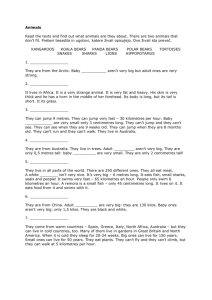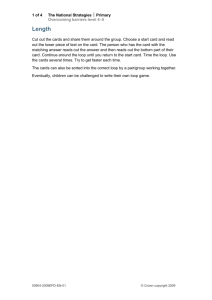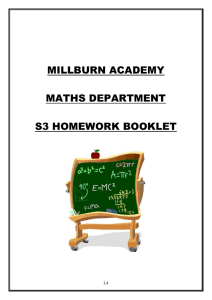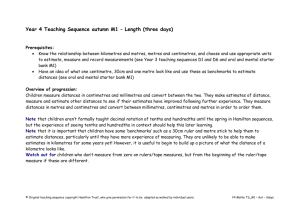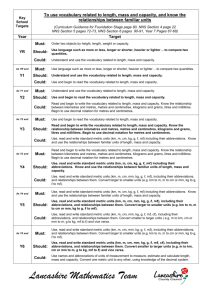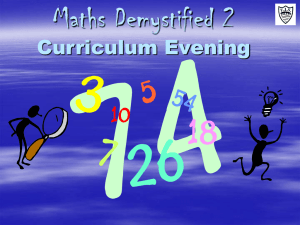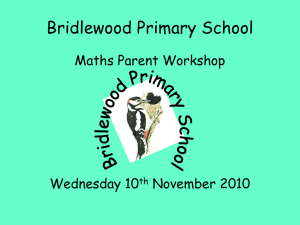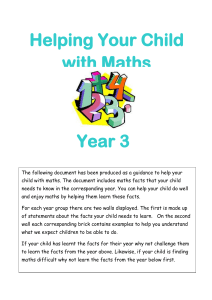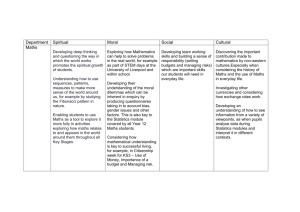Maths Language Jargon Buster for Parents
advertisement
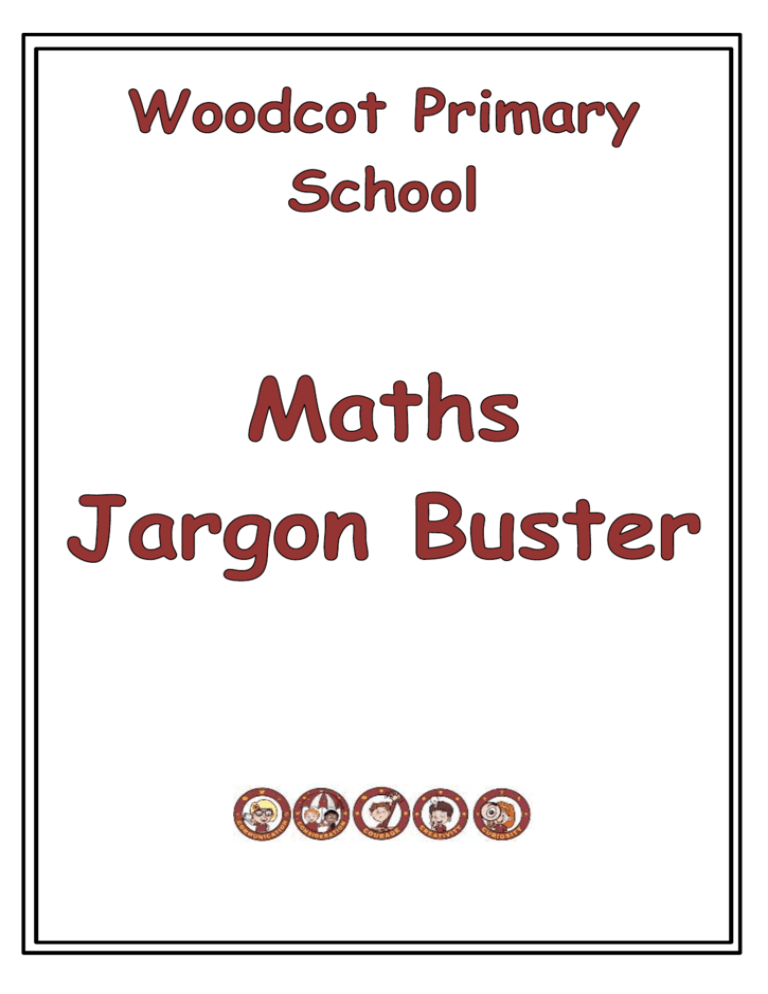
Maths Language array Shapes or objects arranged in a rectangle are called an array. Egg boxes or muffin trays are good examples of arrays. Teachers use these to help children to 'see' multiplication. For example, 4 rows of muffins in a tray times 3, equals 12 muffins. averages: When we talk about averages in everyday life, we are usually referring to the mean average. This is the sum of the numbers in a set of data, divided by the number of members of that set. So if we wanted to know the average age of a group of children, we would add up all their ages and divide by the number of children. There are two other types of average that children may come across in maths. They are: median average: The number in the middle if you place the numbers in a set in order of size. mode average: The most common number in a set (if any of the numbers occur more than once). bar modelling Visual representation of a number using unit cubes, lines (of 10 cubes), sheets (of 100 cubes) and boxes (of 1000 cubes). Used in pictorial approach to solving addition and subtraction problems. chunking Chunking is sometimes used to calculate division. Using multiples of the number that the total has to be divided by breaks down the calculation into sizeable 'chunks' that are subtracted from the total. For example, in 12 ÷ 3 = 4, you 'chunk' into 3s to find the answer, 4. C-P-A (Concrete - Pictorial – Abstract) The concrete-pictorial-abstract approach defines the three steps (or representations) necessary for pupils to develop understanding of a concept. Reinforcement is achieved by going back and forth between these representations. Concrete: This is a 'hands on' component using real objects and it is the foundation for conceptual understanding. Pictorial: The iconic stage - a student has sufficiently understood the hands-on experiences performed and can now relate them to representations, such as a diagram or picture of the problem Abstract: The symbolic stage - a student is now capable of representing problems by using mathematical notation, for example: 12 ÷ 2 = 6 data handling This means using of simple lists, tables and graphs to present information. factor families Factor families are made up of numbers that are related in multiplication and division. For example, the numbers 5, 8 and 40. You can multiply two of the numbers together to get the third number: 8 x 5 = 40. You can switch the order of the two numbers multiplied above to equal the third number again. In maths, this is known as the commutative property of multiplication: 5 × 8 = 40, 8 x 5 = 40. Similarly you can divide one number by the other and equal the third number: 40 ÷ 8 = 5. formal written methods Formal written methods are the standard procedures used for calculations that cannot easily be solved mentally. These include: column addition, column subtraction, short multiplication, long multiplication, short division and long division. grid method Schools sometimes use the grid method to teach multiplication. For example, to work out 35 × 8 using the grid method, you set the numbers out in a grid: You then multiply the numbers and add them together to find the total: inverse operations We say that addition and subtraction are inverse operations; this means that we can use one operation to undo the other, e.g. you can undo adding 5 by taking away 5. Multiplication and division are also inverse operations. If you multiply a number by 10, you can undo this by dividing by 10. Children are taught to use inverse operations to check their answers to a question. If they work out that 15 + 35 = 50, they might check this by subtracting 35 from 50 to see if they get 15. number square A number square is a visual image used in almost all classrooms to help children grasp the concept of number and place value. number bonds Number bonds are pairs which make up a total. The number bonds for seven, for example, are 3 + 4, 2 + 5, 1 + 6 and 0 + 7. Children will practise remembering these at schools. Help them practise at home. number line A number line is a visual image used in almost all classrooms to help children grasp the basic number relationships. Children will use a number line to count forwards and backwards, in, for example, 1s, 2s and 10s depending on the scale of the number line. measurements: units of measure A unit of measure is an agreed quantity by which we measure things. So, metres, centimetres, litres, millilitres, grams and kilograms are all units of measure. metric measurement systems are systems for measuring things in which the units of measure go up in 10s or multiples of 10 (100, 1000 etc). For example kilometres, metres, centimetres and millimetres are the metric system for measuring length and distance: There are 10 millimetres in a centimetre, 100 centimetres in a metre and 1000 metres in a kilometre. We now use metric systems for most of our measuring. imperial measurement systems are systems for measuring things that were developed in England in the 19th century. Examples are pounds and ounces for weighing and inches; yards and miles for measuring length and distance. We do not use them very much now, except miles for measuring distance and pints for volume. converting between units of measure means changing a measurement from one unit (e.g. metres) to another unit (e.g. centimetres). So, the measurement 2 metres can be converted to 200 centimetres. Length and distance are measured in kilometres, metres, centimetres and millimetres. There are: 10 millimetres in a centimetre. 100 centimetres in a metre. 1000 metres in a kilometre. Mass is measured in grams and kilograms. There are: 1000 grams in a kilogram. Volume is sometimes measured in litres and millilitres. There are: 1000 millilitres in a litre. converting between imperial and metric systems of measure It can be useful to be able to convert between some common Imperial systems of measurement and the comparable metric system, e.g. between miles and kilometres. To do this, you need to know the relationship between them. Here are some common examples: There are about 1.6 kilometres in a mile. There are about 0.6 miles in a kilometre. There are about2 pints in a litre. There are about 0.5 litres in a pint. mental maths Mental maths is essentially the ability to calculate mentally, i.e. in your head without writing anything down. Learning things such as number bonds, number patterns, doubles and multiplication tables facts are important mental maths skills. missing number problems A missing number problem is a calculation where one of the numbers has been taken out. The missing number could be represented by a space, question mark or shape, e.g. 4 + ___ = 9 Children have to use related number facts to work out the answer, for instance they may know that 9 – 4 = 5, and therefore deduce that 4 + 5 = 9. This type of question helps to prepare children for algebra, where unknown numbers are represented by letters. one-to-one correspondence This means being able to match one object to one other object or person. Children need to learn this in order to be able to count. This can be practised in a number of different play situations, such as laying the table, or setting out a tea party. For example, each person at the table needs 'one' cup. partitioning Partitioning a number means to expand the number. For example, 58 is partitioned into 50 and 8. It is often used to break down numbers when multiplying or dividing larger numbers to make the calculation easier. For example, 58 × 2 can be broken down into 50 × 2 = 100 and 8 × 2 = 16, giving an answer of 116. place value The value of a digit depends on its place within a number. This is its place value and it is the basis of our entire number system. For example, in 378 there are 8 units (or ones), 7 tens and 3 hundreds. range The range is the difference between the highest and lowest numbers in any given group of numbers, e.g. the age range of a group of children is the difference between the age of the oldest child and the age of the youngest child. ratio Ratios are a way of comparing the amounts of different things, e.g. if a recipe asks for flour and sugar in a ratio of 2:1, it means that you need 2 lots of flour for every 1 lot of sugar that you put in. Each thing in a ratio needs to be measured in the same kind of unit. So, if a recipe asks for flour and sugar in a ratio of 2:1 and you put in 2 cups of flour, you need to put in 1 cup of sugar. If you put in 2 kilograms of flour, you need to put in 1 kilogram sugar and if you put in 2 bathtubs of flour, then you need to put in 1 bathtub of sugar! You may also see ratios on map scales. In this case it tells you the relationship between the distance on the map and the distance in real life, e.g. 1:10,000 would mean that 1cm on the map represents an actual distance of 10,000cm. sequence A sequence is a set of things (usually numbers) that are in an order. Each number in the sequence is called a term. To find missing terms in a sequence, first you need to find the rule behind the sequence. For example, in the sequence '2 4 6 8' the rule is to add two to the previous number. The next number in the sequence would be '10'. shape, space and measure This term is used in curriculum documents and refers to work done with shapes, spatial awareness, (e.g. volume and area) and measurements (e.g. centimetres, metres, litres). two-step problems A word problem that requires two ‘steps’ in order to be solved is a two-step problem. For example, I have £6.50 to spend. If I buy two magazines priced at £1.95 each, how much money will I have left over? This requires two steps because we need to first add £1.95 and £1.95 to each other, and then take away this total from £6.50. (See word problems) using and applying mathematics We use maths in everyday life, drawing upon our maths knowledge and applying it, for example to calculate how much wallpaper we need to buy when redecorating. This is known as 'using and applying' our maths skills in everyday life. word problems A word problem is a problem written in everyday language that requires maths to find the answer. Children will work with word problems frequently. For example, oranges cost 69p a kilo. I pay for a kilo of oranges with a £1 coin. How much change will I get?

